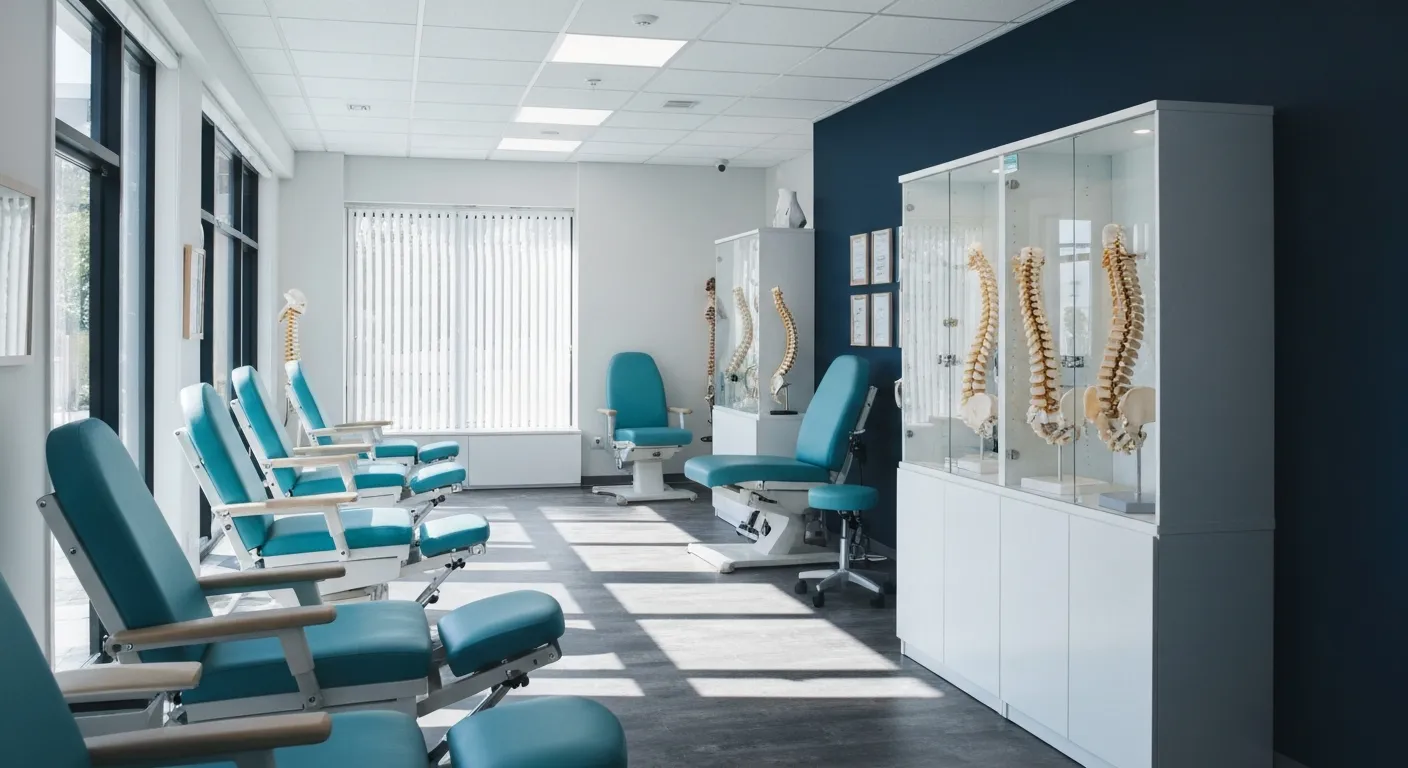Heartwarming Patient Testimonials Highlighting Chiropractic Success
October 15, 2025
14 min

Discovering the Transformative Potential of Chiropractic Care
Chiropractic care has long been regarded as an effective approach for relieving musculoskeletal pain and improving overall wellness. This article delves into heartfelt patient testimonials and clinical evidence that highlight the profound impact chiropractic treatments have had on individuals from all walks of life. Beyond simple symptom management, chiropractic care offers a holistic, personalized approach that addresses root causes and promotes long-term health gains. Through real success stories and expert insights, we explore the journey of healing and renewed vitality that many patients experience with chiropractic interventions.
Addressing Root Causes: The Holistic Approach of Chiropractic Care

How does chiropractic care address the root causes of back pain?
Chiropractic care for back pain targets the underlying causes of back pain rather than just alleviating symptoms. It focuses on spinal misalignment treatment through manual chiropractic adjustments, which restore proper alignment and mobility. Poor posture and relief from muscle tension, common contributors to chronic pain, are addressed with tailored postural training guidance and therapeutic exercises. Additionally, chiropractors consider other factors such as addressing herniated discs and injuries, offering individualized treatment plans that include stress management in chiropractic care and exercise and nutrition advice to support overall health and healing.
What distinguishes chiropractic care from other pain relief methods?
Non-invasive chiropractic treatments are unique due to their drug-free approach. Unlike medications or surgery, chiropractic care emphasizes manual manipulation combined with a holistic chiropractic approach, a whole-body perspective. This approach aims to improve the body's natural healing abilities by focusing on spinal health and its impact on the nervous system. Patients receive individualized treatment plans that promote long-lasting relief and prevent recurrence by addressing lifestyle and emotional factors alongside physical adjustments.
This method provides an effective alternative for those seeking safe pain relief options that avoid pharmaceuticals and invasive procedures. Through consistent chiropractic care, patients often experience improved posture, mobility, and enhanced quality of life.
Heartwarming Patient Success Stories: From Chronic Pain to Renewed Mobility

What are some notable patient success stories attributed to chiropractic care?
Many patients have shared inspiring experiences of overcoming chronic pain and regaining mobility thanks to patient success stories of chiropractic care for back pain. A 63-year-old retired construction worker, for example, found significant relief from severe back pain after about seven weeks of consistent chiropractic treatment success. This holistic approach allowed him to improve his quality of life despite a longstanding history of trauma and hip replacements.
How has chiropractic care helped patients recover from injuries and avoid surgery?
Athletes and active individuals have benefited greatly from chiropractic interventions. A 30-year-old athlete who suffered a lower back injury recovered not only fully but improved his athletic performance beyond pre-injury levels after receiving tailored spinal adjustments, targeted exercises, and lifestyle guidance. Similarly, a patient with severe arthritis and neck issues achieved over 90% improvement in knee function, successfully avoiding surgery through chiropractic care or other orthopedic treatments through chiropractic management.
Can chiropractic care support people of all ages and varying health conditions?
Chiropractic care has proven effective across a broad age range and a variety of conditions. Seniors like Margaret, a 70-year-old woman with back pain and limited mobility, experienced improved movement and reduced pain, enabling her to enjoy activities such as gardening and dancing again. Younger patients, including mothers managing neck and upper back pain and athletes recovering from injuries, also report enhanced comfort and physical capabilities. The individualization of treatment plans helps address each patient's unique needs, maximizing long-term relief and wellness.
These patient stories exemplify how chiropractic care goes beyond symptom management, promoting whole-body health with personalized, non-invasive, drug-free approaches that restore function and enrich lives.
Chiropractic Care and Injury Recovery: Enabling Patients to Regain Normal Activities

How does chiropractic care assist in recovery from injuries?
Chiropractic care aids injury recovery by employing spinal adjustments that realign the spine and restore proper joint function. Alongside these adjustments, therapies such as soft tissue manipulation, stretching, and strengthening exercises target muscle tension and improve mobility.
Effectiveness in sports and injury-related recovery
This approach is notably effective for sports injuries, whiplash, and sprains. For instance, patients with severe ankle sprains have reported sufficient pain relief after chiropractic treatments to return to activities like dancing at family weddings. Athletes recovering from back injuries have regained and even enhanced their performance with chiropractic care (Chiropractic Care for Fall and Car Accident Recovery).
Treatment plans including adjustments and complementary therapies
Treatment plans are personalized and often include complementary therapies such as heat, ice, laser therapy, traction, and nutritional guidance. These holistic plans focus on not just pain relief but long-term healing and injury prevention (Holistic Approach to Chiropractic Care).
Patient experiences resuming everyday and recreational activities
Many patients share success stories of resuming normal daily tasks and recreational activities without pain. A retired construction worker regained mobility after weeks of care, and many others avoided surgery by following consistent chiropractic treatment. These experiences highlight chiropractic care’s role in promoting faster and sustainable recovery from injuries.
Patient Satisfaction and the Therapeutic Relationship in Chiropractic Care

What factors contribute to high patient satisfaction in chiropractic care?
Patients receiving chiropractic care often report high levels of satisfaction, with many studies showing satisfaction rates exceeding 75-90%. Several key factors drive this positive experience.
First, effective communication plays a critical role. Chiropractors take time to listen carefully, explain individualized treatment plans clearly, and actively involve patients in decisions. This approach builds trust and ensures patients feel heard and understood.
Individualized care is another important element. Treatments are tailored to address each patient’s specific needs and conditions, contributing to better clinical outcomes and a more personalized experience.
The therapeutic relationship between chiropractor and patient is characterized by empathy, trust, and ongoing support. Patients appreciate the caring, professional attitude of chiropractors, which enhances overall comfort and confidence during treatment.
Compared to other healthcare providers, chiropractic care often results in higher patient satisfaction. This is partly due to longer appointment times that allow more patient engagement and a holistic approach that focuses on overall wellness rather than just symptom relief.
In summary, the combination of positive health results, clear communication, personalized treatments, and a strong therapeutic bond fosters exceptional patient satisfaction in chiropractic care.
Comprehensive Treatment Approaches: Beyond Spinal Adjustments

What complementary treatments are commonly integrated with chiropractic adjustments?
Chiropractic care often combines spinal adjustments with several complementary therapies to amplify benefits and promote overall health. These include heat and ice applications to reduce inflammation and muscle tension, laser therapy to stimulate tissue healing, and traction methods to decompress the spine.
Nutrition plays an essential role, with chiropractors offering dietary guidance tailored to support recovery and strengthen musculoskeletal health. Postural training is also emphasized, helping patients develop habits that maintain alignment and prevent future pain.
Exercise programs are designed to reinforce adjustments by improving mobility and muscle strength. Additionally, stress management techniques—such as relaxation exercises and mindfulness—address emotional wellness, recognizing the mind-body connection in healing.
Patients benefit from this holistic approach, receiving personalized plans that not only address symptoms but also tackle lifestyle factors. This combination aids long-lasting relief and empowers individuals to maintain their health beyond the clinic.
Overall, integrating these supportive therapies with chiropractic adjustments creates a comprehensive strategy that optimizes patient outcomes and fosters sustained wellness.
Safety and Evidence: Chiropractic Care Backed by Research

What does research say about the safety and efficacy of chiropractic care?
Research over the past decades has established chiropractic care as an effective treatment modality for common musculoskeletal disorders. Clinical studies affirm that spinal manipulation—the core technique used by chiropractors—can significantly alleviate low back pain, neck pain, and certain types of headaches, including migraines (Chiropractic adjustments).
Evidence-based practice and safety profile
chiropractic education and treatment have increasingly embraced evidence-based practice since the 1990s. Chiropractors are licensed professionals trained to deliver safe spinal manipulations and comprehensive conservative care for musculoskeletal conditions. Evidence supports chiropractic interventions such as joint manipulation, soft tissue therapies, exercise prescriptions, and adjunct modalities like nutritional guidance (Evidence-Based Practice in Chiropractic Care).
Serious adverse events from chiropractic care are extremely rare. Minor side effects, noted in some patients, typically involve temporary soreness or mild headaches lasting a few days after treatment. Studies report these effects as self-limiting and generally mild, with a very low incidence of serious complications such as herniated discs or neurological issues when care is administered by trained experts (Risks of chiropractic care).
Effectiveness for common musculoskeletal conditions
Systematic reviews and clinical guidelines advocate spinal manipulation for low back and neck pain and recognize its benefit for headaches originating from cervical sources. Patients often report immediate or rapid pain relief, improved posture, enhanced range of motion, and decreased reliance on medications (Benefits of Chiropractic Care). Chiropractic care may also contribute to slowing the progression of arthritis by promoting joint alignment and mobility (Chiropractic Pain Relief Success Stories).
Rare and minor side effects
Adverse events like muscle soreness, tiredness, or mild dizziness may occur but are mostly transient. Large observational studies on neck pain treatment with chiropractic care highlight that while minor side effects are somewhat common, only a small percentage are severe, and no serious adverse events were commonly recorded. This reinforces the favorable risk-benefit ratio for chiropractic treatment when practiced appropriately (benefits of chiropractic care for neck pain).
In summary, chiropractic care is supported by robust research demonstrating clinical effectiveness and a strong safety profile, making it a valuable, non-invasive option for managing prevalent musculoskeletal pain and dysfunction (Chiropractic care for pain relief).
Long-Term Benefits: Sustained Relief and Improved Wellness

What long-term benefits do patients experience from chiropractic care?
Many patients experience lasting relief from recurring pain and symptoms after undergoing chiropractic care. This is often due to comprehensive treatment plans that not only address immediate discomfort but also target underlying causes such as spinal misalignments, poor posture, and muscle tension. The result is a reduction in the frequency and intensity of pain episodes, including those associated with back, neck, and joint conditions.
Avoiding invasive medical procedures is another significant advantage reported by many patients. Through tailored chiropractic adjustments and complementary therapies like exercise, nutrition guidance, and lifestyle modifications, individuals have successfully managed or even reversed musculoskeletal issues that might otherwise necessitate surgery. For example, some patients with arthritis or herniated discs have noted improvements that helped them circumvent orthopedic interventions.
In addition to pain reduction, enhanced mobility and overall quality of life are commonly cited benefits. Patients regain flexibility, improved posture, and greater range of motion, which enables them to resume daily activities and hobbies without limitation. Seniors, athletes, and individuals with chronic conditions alike report improved physical function and stamina following ongoing chiropractic care.
This holistic approach promotes sustainable wellness by encouraging continued self-care, such as postural training and stress management, leading to long-term health improvements beyond symptom relief.
Chiropractic Care for All Ages: From Infants to Seniors

How does chiropractic care cater to patients of varying ages?
Chiropractic care offers personalized, non-invasive treatments tailored to individuals from infancy through older adulthood. For infants, gentle adjustments can relieve conditions like gas, constipation, and developmental challenges. These subtle manipulations support the nervous system and promote better sleep and comfort (Patient Testimonials).
Active children, including those with sports injuries, benefit from chiropractic therapies that enhance flexibility, reduce muscle tension, and aid recovery. Athletes of all ages receive targeted adjustments and rehabilitative exercises to improve performance and prevent injury (Improving Mobility with Chiropractic Care; Athlete Injury Recovery).
Seniors often face issues like arthritis, spinal misalignment, and reduced mobility. Chiropractic care for elderly patients emphasizes gentle spinal adjustments, postural training, and lifestyle modifications to reduce pain and enhance movement. This approach supports activities such as gardening, walking, and dancing (Benefits for Seniors; Elderly Patient Health Improvements).
By adapting techniques and creating individualized plans, chiropractors address the unique needs of each age group safely and effectively, promoting long-lasting health and well-being across the lifespan (Individualized Treatment Plans; Holistic Chiropractic Approaches).
Patient Testimonials Highlighting Mental and Emotional Health Improvements
How does chiropractic care impact mental and emotional health according to patient reports?
Patients frequently share experiences of enhanced mental and emotional well-being after chiropractic care for depression and anxiety, emphasizing a holistic mind-body approach. Chiropractic treatments often reduce symptoms of anxiety, depression, and stress, creating tangible improvements in quality of life.
Spinal adjustments promote the release of beneficial hormones such as neurotensin, oxytocin, and cortisol, which support positive nervous system function and emotional balance. Additionally, chiropractic therapy helps alleviate muscular tension, headaches, migraines, and insomnia—common physical factors connected to mental health struggles.
These physical reliefs contribute to relaxation and stress reduction, as chiropractic therapy to reduce muscular tension have been shown to lower electrical muscle activity and induce calmness. Patients also report feeling more balanced emotionally, attributing reduced anxiety and depression symptoms to their ongoing chiropractic care.
Ultimately, chiropractic care addresses both physical and emotional health through a comprehensive approach, making it a valuable option for individuals seeking improved well-being beyond traditional treatments.
Personalized Care and Patient Education: Cornerstones of Effective Chiropractic Treatment

Why is personalized care important in chiropractic treatment?
Personalized care in chiropractic treatment is crucial because it ensures that interventions are specifically tailored to a patient's unique condition and lifestyle. Each chiropractic patient has distinct needs influenced by factors such as spinal misalignment treatment, muscle tension, posture, and overall health. Addressing these personalized aspects maximizes the effectiveness of care through individualized treatment plans.
How are thorough assessments and diagnostic tools used?
Chiropractors employ thorough assessments, including detailed physical exams, posture analysis, and diagnostic imaging such as X-rays. These tools help in accurately identifying the root causes of pain and dysfunction, ensuring that treatment targets the underlying issues rather than just symptoms. This leads to more precise and effective adjustments, often involving manual chiropractic adjustments guided by comprehensive chiropractic evaluations.
What role does patient involvement and education play?
Patients benefit greatly from being actively involved in their care. Chiropractors provide education about the condition, treatment goals, and home care practices such as exercises and ergonomic adjustments. This involvement empowers patients, promotes adherence to postural training guidance, and supports long-term health improvements beyond clinic visits, strengthening patient satisfaction with chiropractic care.
By combining individualized treatment plans with detailed assessments and patient education, chiropractic care fosters sustained relief and overall wellness tailored to each patient's needs.
Success in Managing Chronic Conditions Through Chiropractic Care

Can chiropractic care effectively manage chronic conditions?
Chiropractic care has proven effective in managing various chronic conditions, including back pain, headaches, migraines, and arthritis. Patients frequently report significant pain relief and enhanced mobility following tailored chiropractic treatments. These non-invasive chiropractic treatments can reduce the reliance on surgery and medications.
How does chiropractic care help with chronic back pain, headaches, and migraines?
- Chiropractic adjustments realign the spine to relieve pressure and improve function.
- Holistic treatment plans incorporate posture training guidance, exercise, and nutrition guidance.
- Complementary therapies such as heat, laser, and traction enhance results (Heat Ice Laser Traction Nutrition Adjustments.
- Many patients experience decreased frequency and severity of headaches and migraines (Chiropractic treatment success stories).
Are surgery and medications avoidable with chiropractic care?
Numerous success stories reveal that patients have avoided surgical intervention and reduced medication usage by pursuing chiropractic care. For example:
- A patient with severe arthritis improved over 90%, avoiding orthopedic surgery (Significant Arthritis Knee Improvement.
- Patients with chronic back pain have reported long-term relief without opioids (Chiropractic Neck and Back Pain Relief.
What are some documented case improvements?
| Patient | Condition | Outcome |
|---|---|---|
| Keith C., 63 | Moderate to severe lower back pain | Significant pain relief after 7 weeks (Keith C. lower back pain relief |
| Angelena C. | Ankle sprain and arthritis | Walked normally and danced pain-free (Angelena C. ankle sprain and arthritis recovery |
| Pat C. | Neck, upper back, and knee problems | Avoided surgery with 90%+ improvement (Pat C. neck and knee improvement |
| John (office worker) | Chronic low back pain | Regained flexibility and comfort (Transforming Back Pain with Chiropractic Care) |
| Jane | Lower back pain | Surgery avoided, sustained relief (Patient Success Stories |
These accounts emphasize chiropractic care's effectiveness in chronic condition management by addressing root causes and lifestyle factors to promote sustainable health benefits.
Chiropractic Care in Special Healthcare Settings: Veterans and Neurologic Conditions

How is chiropractic care integrated into specialized healthcare settings?
Chiropractic care has become an integral part of specialized healthcare, particularly within the Veterans Affairs (VA) healthcare system. Since 1999, chiropractic services have been included in the VA Medical Benefits Package, providing diagnosis and non-operative management of neuromuscular and musculoskeletal conditions such as low back and neck pain. Veterans access these services through on-site clinics or community care programs, facilitated by referrals from primary or specialist providers. The number of VA chiropractic clinics has expanded significantly, reflecting growing demand and integration into multidisciplinary healthcare teams.
Treatment of neurological symptoms and injuries
Specialized chiropractic practices offer comprehensive care for neurological conditions including brain injuries, cerebral palsy, and related balance and gait issues. Case studies document improvements such as enhanced mobility, reduced pain, and better mental functioning after intensive chiropractic interventions. These treatments are personalized, often combining spinal adjustments with supportive therapies to address complex symptoms of neurological disorders. Patients report meaningful progress in both physical and emotional health, highlighting the effectiveness of chiropractic care beyond traditional musculoskeletal concerns (Success Stories at Neurologic Chiropractic Care, Real Patient Success Stories).
Collaborative multidisciplinary models
Chiropractors working in these special settings often collaborate closely with other healthcare professionals, including primary care physicians, rehabilitation therapists, and pain management specialists. This integrated approach ensures holistic patient care, combining chiropractic adjustments with ongoing physical therapy, exercise prescription, and ergonomic advice. Such teamwork fosters comprehensive treatment plans tailored to individual needs, contributing to improved long-term outcomes for patients with chronic pain and neurological impairments (Chiropractic educational and training integration, Collaborative models promoting patient-centered care).
The Staff Factor: Professionalism and Compassion Enhancing Patient Experiences

How does the professionalism and compassion of chiropractic staff affect patient outcomes?
Patients consistently express gratitude for chiropractic practitioners who combine expertise with genuine care. Many highlight that knowledgeable and caring staff, such as Dr. Adam Williams and others, greatly improve their treatment experience by providing clear explanations and empathetic communication.
This professionalism fosters trust, making patients feel heard and supported, which is crucial for successful recovery. Patients often mention that such interactions not only reduce their anxiety but also motivate them to adhere closely to treatment plans (Patient satisfaction with chiropractic care.
Environment Contributing to Healing
The clinic atmosphere, described as friendly, professional, and welcoming, also plays a significant role in patient satisfaction. A positive environment enhances comfort and encourages ongoing care, which many patients connect to improved health outcomes (Patient Testimonials).
By prioritizing both the technical and emotional aspects of care, chiropractic staff create a healing environment that supports sustained wellness beyond immediate pain relief (Chiropractic care benefits.
A Journey of Healing and Hope Through Chiropractic Care
The wealth of patient testimonials, combined with robust clinical research, affirms that chiropractic care offers more than just pain relief; it transforms lives by addressing underlying causes, promoting holistic health, and empowering patients across all ages and conditions. Through personalized care, comprehensive treatment approaches, and compassionate practitioner involvement, chiropractic care continues to inspire hope and restore quality of life for countless individuals. These heartwarming success stories are a testament to the profound impact of chiropractic healing—a journey marked by renewal, resilience, and lasting wellness.
Recent articles

Sciatica Relief Through Targeted Spinal Decompression

Integrating Physiotherapy with Chiropractic Treatments for Better Results

Testimonials That Demonstrate the Benefits of Chiropractic Care

The Power of Corrective Exercises in Pain Management

A Step-by-Step Guide to Your Initial Chiropractic Consultation

9 Nutritional Tips to Enhance Your Chiropractic Wellness Journey

Patient Experiences: How Chiropractic Care Changed Their Lives

Lifestyle Recommendations to Keep Your Spine in Top Shape

Effective Corrective Exercises for Long-Term Pain Relief

Back Pain Benefits: What Chiropractic Care Can Do for You

Spinal Decompression Techniques for Effective Sciatica Relief

Top Nutritional Counseling Tips for Enhanced Wellness

6 Lifestyle Habits That Boost Spine Health Daily

Discover Holistic and Non-Surgical Pain Relief Solutions

Exploring Holistic and Non-Surgical Treatment Options for Pain

The Role of Physiotherapy in Enhancing Chiropractic Care Outcomes

Complementing Chiropractic Care with Physiotherapy: What You Need to Know

What to Expect During Your First Chiropractic Visit

Simple Lifestyle Adjustments to Maintain a Healthy Spine

Personalized Nutritional Counseling for Improved Health Outcomes

Exploring Non-Surgical Treatments for Spine-Related Conditions

An Introduction to Spinal Decompression for Sciatica Patients

Transformative Success Stories: Patient Experiences with Chiropractic Treatments

Why Chiropractic Care Is Essential for Back Pain Relief

Addressing Underlying Causes Versus Symptom Management in Pain Care

The Role of Nutrition in Enhancing Chiropractic Treatment Effectiveness

Sciatica Treatment Options: Is Spinal Decompression Right for You?

Lifestyle Tips to Maintain a Healthy Spine and Prevent Back Issues

The Synergy Between Physiotherapy and Chiropractic Treatments

What Happens During Your Initial Chiropractic Consultation

Effective Corrective Exercises for Sustainable Pain Management

Taking a Root Cause Approach to Chronic Pain Management

Holistic Pain Management Techniques Without Surgery

How Patient Success Stories Validate Chiropractic Care Benefits

Spinal Decompression: Innovative Treatment for Sciatic Nerve Pain

Spinal Decompression Therapy: A Non-Invasive Approach to Sciatica Relief

Exploring Holistic Approaches Beyond Surgery for Pain Relief

Practical Lifestyle Advice to Support a Healthy Spine Every Day

Corrective Exercise Routines Designed for Long-Term Pain Prevention

Real Patient Stories: Overcoming Chronic Pain with Chiropractic Care

Lifestyle Changes That Promote a Healthy Spine and Prevent Injury

How Addressing the Root Cause of Pain Leads to Lasting Relief

Non-Surgical Holistic Therapies to Manage Chronic Pain Effectively

Nutritional Counseling's Impact on Physical Health and Healing

Benefits of Regular Chiropractic Care for a Stronger Back

Your First Chiropractic Visit: What to Expect and How to Prepare

Patient Experiences: How Chiropractic Care Transformed Their Lives

Exploring Holistic, Non-Surgical Options for Pain Management

Combining Physiotherapy with Chiropractic Treatments for Enhanced Recovery

Holistic Treatments That Offer Alternatives to Surgery for Pain Relief

Corrective Exercise Strategies for Long-Term Spine Health

How Physiotherapy Complements Chiropractic Adjustments for Better Outcomes

First-Time Chiropractic Visitors: What You Should Know

Understanding the Importance of Treating Pain at Its Source

Adopting Lifestyle Changes to Support Your Spine's Wellness

Utilizing Physiotherapy to Enhance Chiropractic Treatment Outcomes

The Key Advantages of Chiropractic Care for Back Pain Sufferers

Why Focusing on Root Causes Improves Pain Treatment Success

Corrective Exercises That Promote Lasting Pain Relief and Mobility

Sciatica Relief Through Targeted Spinal Decompression Techniques

Preparing for Your First Chiropractic Appointment with Confidence

Healthy Lifestyle Habits for Maintaining Spinal Alignment

Success Stories Highlighting Chiropractic's Role in Pain Recovery

Top Benefits of Chiropractic Care for Chronic Back Pain

Nutrition Tips to Boost Your Overall Wellness and Recovery

How Chiropractic Care Alleviates Back Pain Naturally

How Nutritional Counseling Supports Overall Wellness and Spine Health

Step-by-Step Guide to Your First Visit with a Chiropractor

Using Nutrition to Support Chiropractic and Overall Wellness

Integrating Physiotherapy in Your Chiropractic Healing Journey

How Physiotherapy Complements Chiropractic Adjustments for Faster Healing

Lifestyle Tips for Maintaining a Healthy Spine and Preventing Back Pain

Heartwarming Patient Testimonials Highlighting Chiropractic Success

How Proper Nutrition Supports Chiropractic and Physiotherapy Treatments

Combining Physiotherapy and Chiropractic Treatments for Optimal Recovery

Why Chiropractic Treatments Are Effective for Managing Back Pain

Choosing a Chiropractor: Tips for Finding a Trusted Provider

Integrating Physiotherapy and Chiropractic: Benefits and What to Expect

How Tailored Corrective Exercises Can Aid in Pain Management

Chiropractic Care: A Proven Solution for Alleviating Back Pain

What to Expect at Your First Chiropractic Visit: A Comprehensive Guide

The Importance of Root Cause Analysis in Effective Pain Management

The Role of Corrective Exercises in Sustaining Pain-Free Living

Combining Chiropractic and Physiotherapy for Comprehensive Pain Relief

How Addressing Underlying Causes Improves Pain Treatment Effectiveness

Maintaining Spinal Health Through Lifestyle Changes and Preventive Care

Understanding the Benefits of Chiropractic Adjustments for Back Pain Sufferers

Spinal Decompression Therapy: A New Hope for Sciatica Relief

Lifestyle Recommendations to Support a Healthy Spine and Reduce Pain

Choosing the Right Chiropractor: Key Factors to Consider Before Your First Appointment

Non-Invasive Treatment Alternatives: A Holistic Approach to Pain Relief

Corrective Exercises to Support Long-Term Relief from Chronic Pain

Exploring Non-Surgical Approaches to Spine Health and Wellness

Tips for Daily Habits That Keep Your Spine Strong

Success Stories: How Chiropractic Treatments Changed Lives

Why Focusing on the Root Cause of Pain Leads to Better Outcomes

Nutritional Counseling and Its Impact on Overall Wellness and Recovery

Patient Testimonials That Showcase the Power of Chiropractic Care

Preparing for Your First Chiropractic Appointment: What You Need to Know

